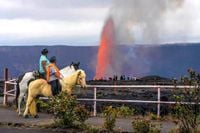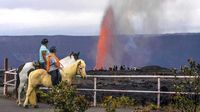Lava fountains, glowing skies, and the ever-present hum of the earth’s energy—Kilauea volcano on Hawaii Island is once again putting on a show that’s as breathtaking as it is unpredictable. In the coming days, scientists expect Kilauea to erupt for the 31st time since December 2024, reaffirming its reputation as one of the world’s most active volcanoes. For residents, visitors, and cultural practitioners, this ongoing eruption is more than just a spectacle; it’s a living connection to the island’s land, history, and traditions.
According to the Associated Press, the latest eruption features lava bursting from two vents at the summit’s Halemaumau Crater, sending molten rock shooting into the night sky. The sight is nothing short of mesmerizing: red and orange hues dance across the crater, reflecting off the oozing lava and setting the darkness aglow. For those lucky enough to be at Hawaii Volcanoes National Park, it’s a front-row seat to nature’s own fireworks. For the rest of the world, the U.S. Geological Survey’s livestreams—offering three camera angles—bring the drama right into living rooms and classrooms everywhere.
Park Service volunteer Janice Wei is among those who never tire of the volcano’s performance. Whenever word comes that the lava is flowing, she rushes to capture photos and videos of Halemaumau Crater. “Every eruption feels like I am sitting in the front row at nature’s most extraordinary show,” Wei told the Associated Press. The experience is immersive: when the molten rock shoots high into the air, she says, it sounds like a roaring jet engine or crashing ocean waves. The heat? She can feel it from over a mile away.
Kilauea’s location, about 200 miles south of Honolulu on Hawaii Island—the largest in the archipelago—makes it both accessible and awe-inspiring. The volcano has been especially active since December 2024, with magma following the same pathway to the surface for all 31 episodes. Ken Hon, scientist-in-charge at the Hawaiian Volcanoes Observatory, explained to the AP that magma is currently entering a lower chamber beneath Halemaumau Crater at a rate of about 5 cubic yards (3.8 cubic meters) per second. This influx inflates the chamber, pushing magma into an upper reservoir. Eventually, the pressure becomes too much, and the magma bursts above ground through cracks, sometimes soaring over 1,000 feet (300 meters) into the air.
The mechanics behind these towering lava fountains are fascinating. As magma rises, it releases gases, which help propel the molten rock skyward. The process is a bit like a shaken bottle of champagne: when the cork finally pops, the contents explode outward. According to Hon, this is only the fourth time in 200 years that Kilauea has produced such repeated, dramatic fountains. Previous episodes of this nature occurred in 1959, 1969, and during the massive eruption that began in 1983 and continued in various forms for three decades, only ending in 2018.
But how long will this current eruption last? That’s the million-dollar question. Scientists use an array of sensors around the volcano to detect earthquakes and subtle changes in ground angle—clues that indicate when magma is on the move. These tools allow them to predict new lava episodes a few days to a week in advance. Still, the volcano has a mind of its own. Sometimes, as in 1983, pressure builds until a new vent opens at a lower elevation, leading to continuous lava flows rather than periodic fountains. Other times, the activity simply stops if the magma supply dwindles.
Steve Lundblad, a geology professor at the University of Hawaii at Hilo, told the AP that the recent lava fountains have been a bit shorter than earlier in the cycle. He suspects the vent has widened, reducing pressure and causing the eruptions to be broader but not as high. “We’re still gonna have spectacular eruptions,” he said. “They’re just going to be wider and not as high.”
For many, lava flows are a symbol of destruction. But for Huihui Kanahele-Mossman, executive director of the Edith Kanakaʻole Foundation, they’re a vital force of creation. “Lava is a natural resource that hardens into land and forms the foundation for everything on Hawaii Island,” Kanahele-Mossman explained to the AP. Her nonprofit, named after her grandmother—a revered Hawaiian language and culture practitioner—teaches a style of hula rooted in the stories of Pele, the volcano goddess, and her sister Hiʻiaka. Each eruption is an opportunity to connect those stories with the present. At the crater, Kanahele-Mossman performs traditional chants and leaves offerings such as awa (a kava drink) and fern lei, honoring Pele and the land itself. “You as the dancer, you are the storyteller and you carry that history that was written in those mele forward,” she said. “To be able to actually see that eruption that’s described in the mele, that’s always exciting to us and drives us and motivates us to stay in this tradition.”
The volcano’s activity has had a noticeable impact on tourism. Hawaii Volcanoes National Park has seen visitation rise every month this year. In April, there were 49% more visitors compared to April 2024, a surge attributed in part to the ongoing eruption. Park spokesperson Jessica Ferracane noted that recent eruption episodes typically last just 10 to 12 hours. She advised would-be visitors to sign up for U.S. Geological Survey alert notifications—otherwise, the show might be over before they arrive.
Safety remains a top concern. Ferracane cautioned that guests must stay on marked trails and overlooks, as unstable cliffs and hidden cracks pose serious risks. Volcanic gases, glass, and ash can also be hazardous, especially for children. Those visiting at night should bring a flashlight, and everyone is urged to keep a close eye on young family members.
For those unable to make the journey, the USGS livestreams offer a safe and mesmerizing alternative. Hundreds of thousands tune in to witness the lava’s journey from the earth’s depths to the open sky, marveling at the raw power and beauty that Kilauea delivers time and again.
As the volcano continues its unpredictable dance, Kilauea stands as both a scientific marvel and a cultural touchstone. It’s a reminder that Hawaii’s landscape is always in flux, shaped by forces both ancient and immediate—forces that inspire awe, caution, and an enduring sense of connection for all who witness them.

